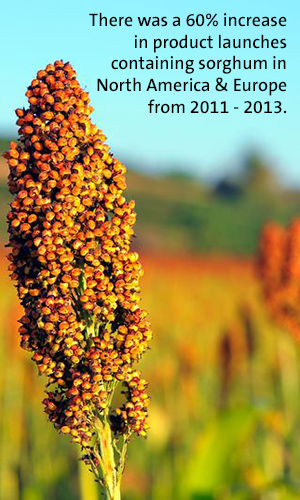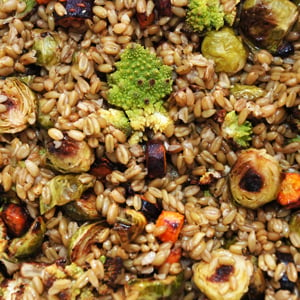 You asked, and we listened! Based on the feedback of our members, ancient grains (EU) are front and center in my next two articles. I’ll cover some well-known and less familiar grains that fall into this category, including history, flavor profiles, applications and more. So let’s get started! Read about sorghum and freekeh below.
You asked, and we listened! Based on the feedback of our members, ancient grains (EU) are front and center in my next two articles. I’ll cover some well-known and less familiar grains that fall into this category, including history, flavor profiles, applications and more. So let’s get started! Read about sorghum and freekeh below.
Sorghum
Dating back to 8000 B.C.E. in Egypt, sorghum (EU) is truly an ancient grain. As a dietary staple for over 500 million people, sorghum is one of the top five foods that provide 85 percent of the world’s food energy, following rice, wheat, maize and potatoes. Sorghum gets its popularity due to its ability to grow in both mild and dry climates, as well as its resistance to drought, heat and floods.
Sorghum has a faintly sweet, mild flavor that blends well with other grains. Also called milo, jowar or dura in some regions, sorghum is used as a food crop in Africa and Asia. In the US, it has been popularly used for feed and ethanol production. Recently, however, it has had a resurgence in foods in both the US and EU due to its gluten-free status, making it safe for people with celiac disorders to consume. This may explain the 60 percent increase in product launches containing sorghum in North America and Europe from 2011 to 2013, according to Mintel’s Global New Products Database.
Whole grain sorghum (EU) with the bran removed resembles tiny pellets similar to millet and can be cooked and used in a similar manner to rice, barley and pasta. Flaked pieces can be used for toppings or included in bars and cookies, while puffed pieces resemble miniature popcorn and can be eaten alone or as a cereal.
Pregelatinized sorghum may be used in beverage applications where suspension is needed. It can also work in baked goods to aid in moisture management, thus extending shelf life. Sorghum flour (EU) can be used for gluten-free bread formulations, but it should be paired with xanthan gum or other binding ingredients to aid in producing a machinable product with acceptable texture. Sorghum flour can also be used in batters, and it produces a crispy coating.
Additionally, Sorghum can be malted and used as a replacement for barley when crafting beer. Sorghum syrup (EU), also known as sorghum molasses, can be made and used in beverages, baked goods and sauces.

Freekeh
Freekeh is wheat that is harvested when it is soft, young and green. It is then parched, roasted and rubbed to remove the husk, producing a smoky, nutty flavored wheat kernel. Freekeh is a cousin to bulgur wheat (EU), and its name is Arabic for “rubbed.” Thus, the name freekeh refers to the process that the grain undergoes, rather than the variety of wheat.
This ancient grain is commonly found in whole and cracked forms, which might be sized for consistency and require soaking or cooking prior to use. It can be ground into flour, which adds a unique flavor to breads and pizza crusts. Freekeh is high in fiber, protein and calcium, contains high levels of resistant starch and is rich in lutein. However, freekeh is not gluten-free and should not be used in formulating products for this category.
Freekeh is commonly found in Middle Eastern and Lebanese dishes, and can be readily substituted in rice or couscous dishes, such as pilaf or tabbouleh. Consider it for a hearty addition to soups or veggie burgers, as an ingredient for meatballs or stuffed peppers to lend a distinctive texture, or as a unique addition to curries in Thai dishes. It would also lend a novel flavor to cooked multigrain cereals and stuffings.
Looking for sorghum or freekeh to supplement your ancient grain formulations? Check out these resources:
Sorghum Ingredients in Prospector® (EU)
Freekeh Ingredients in Prospector®
Ale and Lager Formulas using Sorghum in Prospector®
Additional resources:
Sorghumcheckoff.com – The Sorghum Story Booklet, includes nutrition information
Agricultural Marketing Research Center – Sorghum Handbook, includes recipes
Whole Grains Council – Sorghum, grain of the month
Supermarketguru – Get More Grains: Freekeh
Academy of Nutrition and Dietetics – Freaky about Freekeh: Ancient Grain a Nutrition Powerhouse
Whole Grains Council – Freekeh: The Hot New Ancient Grain
The views, opinions and technical analyses presented here are those of the author or advertiser, and are not necessarily those of ULProspector.com or UL Solutions. The appearance of this content in the UL Prospector Knowledge Center does not constitute an endorsement by UL Solutions or its affiliates.
All content is subject to copyright and may not be reproduced without prior authorization from UL Solutions or the content author.
The content has been made available for informational and educational purposes only. While the editors of this site may verify the accuracy of its content from time to time, we assume no responsibility for errors made by the author, editorial staff or any other contributor.
UL Solutions does not make any representations or warranties with respect to the accuracy, applicability, fitness or completeness of the content. UL Solutions does not warrant the performance, effectiveness or applicability of sites listed or linked to in any content.


